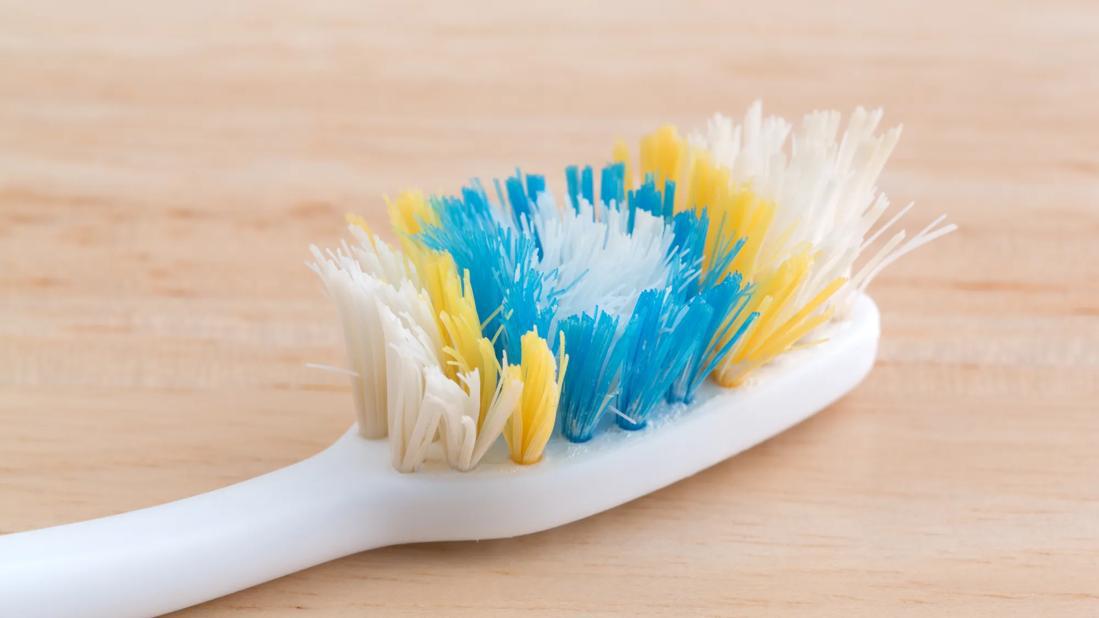How Often To Change Your Toothbrush
An old, worn toothbrush is a hazard to your teeth and gums and a breeding ground for germs and bacteria — replace it every three to four months at least

We all know the basics of how and when to brush our teeth. But if you’re not changing your toothbrush on the regular, all that effort to keep your pearly whites in tip-top shape may not be getting you the results you’re hoping for. Letting an old toothbrush linger around can even do serious damage.
Dentist Sonoko Nakasato, DMD, shares advice for keeping your toothbrush working for you.
When should you change your toothbrush?
The American Dental Association is clear in its recommendations: Change your toothbrush every three to four months, minimum.
That may coincide with the colored bristles turning white. And it may not. So, rather than paying attention to the color of your brush, keep an eye on the calendar.
There are situations, too, when you’ll want to change it up before that three-month timer runs out. Switch out your toothbrush if:
- It looks damaged or frayed
- You’ve been sick
- It’s been through the ringer (like dropped in the toilet, rattled around in your bag, chewed on by a pet or neglected for long stretches in a travel case)
The trouble with keeping a toothbrush for too long
A fresh toothbrush is a safe and effective toothbrush. One that’s been used day in and day out for months on end is more likely to be a home for bacteria. What’s more, that daily wear and tear takes a toll, making your toothbrush less effective at cleaning away plaque over time.
Dr. Nakasato elaborates.
Germ magnet
Sure, you probably rinse your toothbrush after each use. Maybe you even run your fingers over the bristles to clear out old toothpaste and gunk. But the ol’ rinse-and-go method doesn’t kill the germs that can hide in your toothbrush.
“Your mouth is full of bacteria. Some are good, some are bad. And those bacteria can cling to our toothbrushes,” Dr. Nakasato points out. “You need to replace it often so you’re not growing a community of bacteria on your toothbrush.”
That’s also why it’s recommended to change your toothbrush after being sick with illnesses like the flu or strep throat. Germs are tough little things. They can continue to live and thrive on your toothbrush, even after you recover. That means you could be reinfected by the viruses and bacteria that have been hanging out on your brush.
Damaged bristles do damage
Brushing your teeth is an important habit. But over time, those thousands of back-and-forth swipes add up to some serious wear on your toothbrush. And a toothbrush that’s seen better days can’t do its job as well.
For starters, bristles that aren’t standing at attention don’t scoop away plaque and bacteria as well. That can keep your teeth from being less-than-pearly white. And it can lead to things like cavities and gingivitis.
What’s more, damaged bristles can hurt your teeth and your gums.
“Bristles that are frayed can mean doing more abrasive movements,” Dr. Nakasato warns. “So, you can start to brush away your enamel, which is the outer layer of your teeth. You can even start to brush away bits of your gums, which can lead to gum recession, where your gums pull away from your teeth.”
Do electric toothbrushes last longer?
Replacing electric toothbrush heads can get expensive, so you may be tempted to stretch out their shelf life a little longer than that three-to-four-month mark.
Not a good idea. Electric toothbrushes aren’t immune to the germs and damage that plague any other toothbrush.
“Electric toothbrushes are great at getting the plaque and buildup off your teeth. But they need to be switched out just as often as a manual toothbrush,” Dr. Nakasato advises.
That's because even though your electric toothbrush is doing a lot of the work for you — with its rotating bristles and buzzing action — it’s still wearing at the same rate as the manual variety. And it, too, can harbor germs from your mouth and the environment.
Tips for making your toothbrush last
If your toothbrush isn’t making it three months without needing an upgrade, there are steps you can take to make it last better.
- Store it upright so it can dry thoroughly.
- Don’t store your toothbrush in a closed case.
- Rinse it thoroughly after every use.
- Never share your toothbrush.
- Don’t brush too hard (extra pressure doesn’t mean extra clean).
And if you have trouble remembering when to change it? Mark it on your calendar, set a reminder on your phone or write the date on your toothbrush with a permanent marker. There are also subscription services that will mail you a new toothbrush or a replacement head for your electric toothbrush every three months. When it arrives, you know it’s time to make the swap.
Keep up the good brushing!